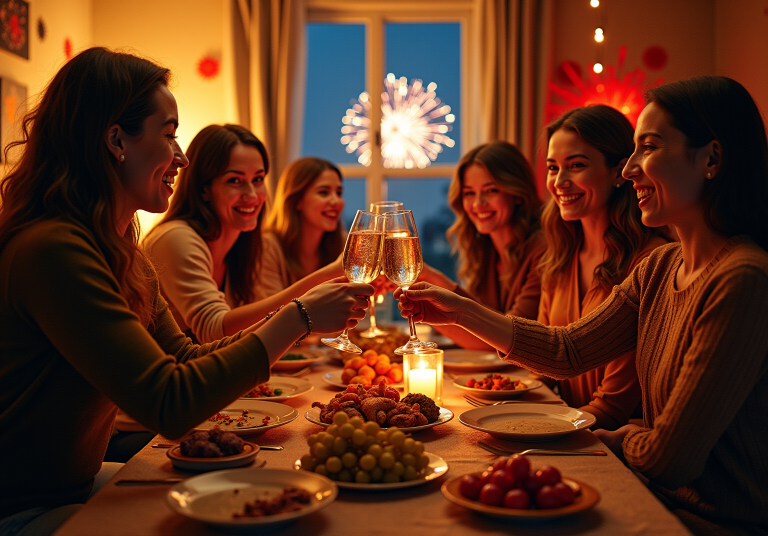Overview
This article takes you on a delightful journey through various New Year traditions from around the world, showcasing their unique cultural significance and the hopes they embody for renewal and prosperity.
Picture this:
- In Spain, people eat grapes at midnight for good fortune.
- In Thailand, they release birds to let go of past difficulties.
These vibrant customs not only enrich celebrations but also foster a deeper appreciation for cultural diversity. Isn’t it fascinating how different practices can connect us all?
Key Highlights:
- In Spain, eating 12 grapes at midnight symbolizes good fortune for each month of the year.
- Colombians carry an empty suitcase around the block to attract travel opportunities.
- Japan’s ‘osechi’ meal represents prosperity and happiness, while bells ring 108 times to symbolize releasing earthly desires.
- Scotland’s first-footing tradition believes the first visitor after midnight brings good luck.
- The Philippines celebrates with round fruits and polka dots, symbolizing prosperity.
- In Thailand, releasing birds on New Year’s Eve signifies letting go of past difficulties.
- Estonians traditionally feast seven, nine, or twelve times on New Year’s Day for prosperity.
- In Denmark, smashing plates against friends’ doors is a fun way to ward off bad luck.
- Italians wear red undergarments on New Year’s Eve to attract love and good fortune.
- In South Africa, throwing old furniture out of windows symbolizes getting rid of the old.
- Ecuadorians burn effigies called ‘Año Viejo’ to let go of the past year and its misfortunes.
Introduction
As you prepare to welcome a new year, vibrant traditions from around the world come alive, reflecting unique values and aspirations. Picture this:
- In Spain, people eagerly eat grapes at midnight, counting down the seconds to the new year.
- In Japan, families gather for reflective meals that honor their past.
- Each custom offers a glimpse into the hopes and dreams that accompany the turning of the calendar.
- Whether it’s the joyous fireworks lighting up the sky in China or the symbolic first-footing tradition in Scotland, these practices not only celebrate the arrival of a new year but also weave a rich tapestry of global festivities.
Embracing these customs can truly transform your personal celebrations, fostering a deeper appreciation for cultural diversity and enriching the experience of renewal that the New Year embodies.
Explore Global New Year Traditions
Embark on a delightful journey through the fascinating customs that highlight around the world New Year traditions! Each tradition reflects unique cultural values and aspirations for renewal, and I can’t wait to share them with you:
In Spain, as the clock strikes midnight, revelers munch on 12 grapes—one for each chime—symbolizing good fortune for every month ahead. What a fun way to celebrate!
Colombia has a charming custom where people carry an empty suitcase around the block. This quirky tradition is thought to attract travel opportunities in the year to come. Can you imagine the adventures waiting for you?
In Japan, families gather for ‘osechi’, a traditional meal filled with various foods, each representing prosperity and happiness. It’s a beautiful time for togetherness and reflection. Plus, the Joya no Kane tradition sees Buddhist temples ringing their bells 108 times at midnight, symbolizing the release of 108 earthly desires. Such a meaningful way to ring in the New Year!
Over in Scotland, the Hogmanay celebration features the tradition of first-footing. The first guest to enter a home after midnight is believed to bring good fortune for the upcoming year. How exciting to be that lucky guest!
In the Philippines, families showcase and enjoy round fruits, which symbolize prosperity. They often wear polka dots to emphasize abundance. It’s all about attracting good vibes!
Meanwhile, in Thailand, releasing birds on New Year’s Eve symbolizes letting go of past difficulties and embracing fresh beginnings. What a liberating way to start anew!
And in Estonia, it’s traditional to feast seven, nine, or twelve times on New Year’s Day, as these numbers are considered fortunate. It’s a wonderful way to highlight aspirations for a prosperous time ahead through around the world new year traditions! These lively customs not only honor the New Year but also weave together the aspirations and desires of various cultures. Embracing these traditions can lead to a joyful beginning of the new cycle. So, which one will you try this year?
Understand Local Customs and Significance
Each New Year tradition carries its own unique significance, and exploring around the world new year traditions can be quite the adventure, such as eating grapes in Spain at the stroke of midnight! This delightful practice is rooted in the belief that each grape you eat will bring good fortune for every month of the year. What a tasty way to welcome the new year!
- First-Footing in Scotland: Picture this: the first visitor to your home after midnight is believed to bring luck! It’s especially lucky if they’re a dark-haired male, symbolizing prosperity. It’s a wonderful tradition that adds a touch of excitement to the festivities.
- Fireworks in China: Now, let’s talk about fireworks! They’re not just for show; they’re ignited to frighten away malevolent spirits and greet the new year with joy and festivity. Can you hear the crackling and popping? It’s a vibrant way to celebrate!
- Jumping Waves in Brazil: Have you ever leaped over waves at the beach? In Brazil, it’s a tradition to jump over seven waves, with each wave representing a desire for new beginnings. It’s a fun and refreshing way to embrace what’s ahead by learning about around the world new year traditions; by understanding these customs, you can appreciate the hopes and aspirations they embody, enriching your own celebrations. So, why not incorporate a few of these traditions into your New Year’s festivities? You might just find a new favorite way to celebrate!

Engage with Unique Traditions from Different Countries
Here are some unique traditions to consider!
- Denmark: Smashing plates against friends’ doors is a fun way to ward off bad luck and welcome good fortune.
- Italy: Donning red undergarments on New Year’s Eve is thought to attract love and good fortune in the upcoming twelve months—how exciting is that?
- South Africa: In some areas, people throw old furniture out of their windows to symbolize getting rid of the old and welcoming the new. Can you imagine that?
- Ecuador: Burning effigies called ‘Año Viejo’ represents letting go of the past year and its misfortunes. It’s a powerful way to start fresh!
Participating in around the world new year traditions can add a distinctive touch to your New Year’s festivities, giving you a chance to connect with cultures from around the globe. So, why not embrace these traditions and make your celebration even more memorable?

Incorporate Traditions into Your Own Celebrations
Incorporating around the world new year traditions into your festivities can truly enhance the experience and cultivate a greater appreciation for cultural diversity! Here are some steps to guide you:
- Research: Start by choosing a few customs that resonate with you. Dive into their historical and cultural significance to understand why they matter.
- Plan: Think about how you can weave these customs into your celebration. For instance, you might prepare a traditional dish from a culture you admire, like Ropa Vieja from Cuba, or try the grape-eating countdown popular in Spain to ring in the New Year.
- Invite Friends: Share these practices with your friends and family! Encourage them to join in and engage with the new customs. This collective experience can really elevate the celebration.
- Create a Theme: Consider establishing a cultural theme for your gathering. You could host a Cuban night featuring traditional dishes and music, or a Spanish tapas night with small plates and vibrant flavors. How about a Scottish Hogmanay party, complete with traditional music and customs?
- Reflect: After the festivities, take a moment to reflect on the significance of around the world new year traditions and how they can inspire your aspirations for the coming year. By thoughtfully integrating these global customs, including those from Cuba, you can craft a celebration that not only honors cultural diversity but also strengthens personal connections, making your New Year truly meaningful!
Conclusion
As the New Year approaches, the rich tapestry of global traditions gives us a wonderful chance to celebrate renewal and cultural diversity! From Spain’s grape-eating ritual to Japan’s reflective family meals, each custom holds the hopes and dreams of different cultures. These practices not only mark the arrival of a new year but also remind us of the values and aspirations that unite us.
Understanding the significance behind these traditions deepens our appreciation for the diverse ways people around the world welcome new beginnings. Whether it’s the joyous fireworks in China or the first-footing custom in Scotland, each ritual carries a message of hope, luck, and community. Engaging with these customs can truly transform our personal celebrations, fostering connections across cultures and enriching our New Year experience.
Incorporating these vibrant traditions into your festivities allows for a deeper connection to the world and its myriad cultures. By researching, planning, and sharing these customs, you can create a celebration that not only reflects your aspirations but also honors the rich diversity of human experience. Ultimately, this approach adds joy and meaning to the New Year while cultivating a spirit of unity and understanding in our rapidly changing world.
Frequently Asked Questions
What is the tradition in Spain for celebrating New Year?
In Spain, as the clock strikes midnight, people eat 12 grapes—one for each chime—symbolizing good fortune for each month of the upcoming year.
What unique custom do Colombians have for the New Year?
Colombians have a tradition of carrying an empty suitcase around the block, which is believed to attract travel opportunities in the coming year.
What do families in Japan do to celebrate the New Year?
In Japan, families gather for ‘osechi’, a traditional meal symbolizing prosperity and happiness. Additionally, Buddhist temples ring their bells 108 times at midnight to signify the release of 108 earthly desires.
What is the significance of first-footing in Scotland’s Hogmanay celebration?
In Scotland, first-footing is the tradition where the first guest to enter a home after midnight is believed to bring good fortune for the new year.
How do families in the Philippines celebrate the New Year?
Families in the Philippines showcase round fruits, which symbolize prosperity, and often wear polka dots to emphasize abundance.
What is the New Year tradition in Thailand?
In Thailand, releasing birds on New Year’s Eve symbolizes letting go of past difficulties and embracing fresh beginnings.
What is the New Year’s Day tradition in Estonia?
In Estonia, it is traditional to feast seven, nine, or twelve times on New Year’s Day, as these numbers are considered fortunate, highlighting aspirations for a prosperous year ahead.


































